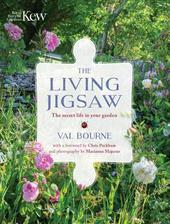
|
The Living Jigsaw: How to cultivate a healthy garden ecology
Hardback
Main Details
| Title |
The Living Jigsaw: How to cultivate a healthy garden ecology
|
| Authors and Contributors |
By (author) Val Bourne
|
| Physical Properties |
| Format:Hardback | | Pages:240 | | Dimensions(mm): Height 246,Width 186 |
|
| Category/Genre | Garden design and planning
Organic gardening |
|---|
| ISBN/Barcode |
9781842466261
|
| Classifications | Dewey:635.0484 |
|---|
| Audience | |
|---|
| Illustrations |
Colour plates
|
|
Publishing Details |
| Publisher |
Royal Botanic Gardens
|
| Imprint |
Kew Publishing
|
| Publication Date |
7 March 2017 |
| Publication Country |
United Kingdom
|
Description
After decades of emphasis on pest control, often achieved through chemical means, gardeners around the world are beginning to come around to a new - or, really, old - way of thinking: a garden whose very diversity of plant and animal life makes it healthy, beautiful, and productive. If you've been wanting to make that change, The Living Jigsaw is the book for you. This masterclass in natural gardening outlines a cornucopia of tried-and-true techniques to help you develop a healthy garden ecology. Val Bourne introduces both new and experienced gardeners to the wide diversity of birds, animals, insects, and even slugs that help bring a natural balance to a home garden - and help its plants and flowers shrug off problems before they become entrenched. This season-by-season guide offers planting strategies, tips for successful cultivation, and new insights into the interactions between plants and animals that are an essential part of any healthy garden. As much a celebration of natural gardening as a how-to book, and written both to teach and to inspire, The Living Jigsaw will help you make sure that your green thumb is truly, ecologically green.
Author Biography
Val Bourne is an award-winning garden writer, photographer and lecturer. She gardens on the windswept Cotswolds at Spring Cottage - high above Bourton-on-the-Water in Gloucestershire. Her third of an acre garden is managed without using chemicals - something Val has always believed in. She is a hands on gardener and a committed plantaholic. Val has been gardening naturally for sixty years (she started very young!) and has written about her previous Oxfordshire garden in an award-winning book The Natural Gardener (2004). Her other books include The Winter Garden (2006), Colour in The Garden (2011), and The Ten-Minute Garden Diaries (2011). Val also writes regularly for The Daily Telegraph, the Hardy Plant Society Journal and many other magazines. She was named Journalist of the Year at the 2014 Garden Media Guild Awards.
ReviewsSo often, wildlife gardening is seen as something 'other' to gardening, to be tolerated rather than desired, something messy rather than pretty, that involves compromise or turning a blind eye. Not so here. This is an all-round book that brings wildlife into gardening and sees wildlife as a key part of the garden. From descriptions of the first Narcissus as the year starts, to tips on how to avoid box blight, the author takes us on a journey through her Cotswold garden at Spring Cottage. Along the journey she introduces the wildlife living there and explains how it fits into the garden's ecosystem. The book is the perfect mix of blooms and butterflies, hostas and hedgehogs. It includes plant lists for filling gaps and extending the season, to luring butterflies and feeding bees. The author describes her 'Damascene moment' when, in the late 1990s, she realised why her former garden thrived without chemicals: it was simply itswildlife. The moment influenced the theme of her book The Natural Gardener (2004) in which she describes the insects, birds and other species that worked as part of the ecosystem to keep the garden healthy. An almost-tragic sequel, The Living Jigsaw describes the staggering decline of the very wildlife helping her gardens work. It need not be tragic. We can all take elements from this book and use them in our own gardens. We can plant for bees and butterflies, tolerate aphids and the wasps that eat them, encourage beetles to eat our slugs. We can have beautiful gardens, for where there is wildlife, there is beauty. -- Kate Bradbury * The Garden | *
|